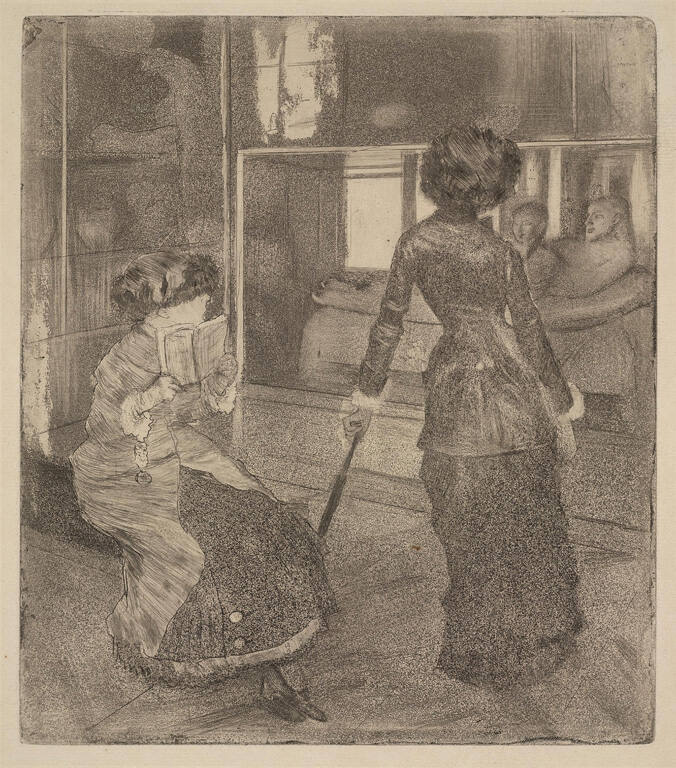
Object Details
Artist
Edgar Degas
Date
1879–80
Medium
Softground etching, drypoint, aquatint, and etching; ninth state of nine
Dimensions
10 1/2 x 9 1/8 inches (26.7 x 23.2 cm)
Credit Line
Bequest of William P. Chapman, Jr., Class of 1895
Object
Number
57.125
Degas drew his friend Mary Cassatt standing, with her sister Lydia, looking at the Sarcophagus of th(…)
Degas drew his friend Mary Cassatt standing, with her sister Lydia, looking at the Sarcophagus of the Spouses in the Musée du Louvre’s Etruscan gallery. Degas’s print was made for the first issue of a (failed) collaborative journal of original prints, Le Jour et la Nuit, where it would have joined prints by his colleagues Cassatt, Pissarro, and Bracquemond. The highly complex, pictorial techniques closely associated with these painter-printmakers were influenced by their graphic work in other media. In this case Degas’s original design was made in pastel. Mary Cassatt at the Louvre is one of only three works by Degas in the Johnson Museum’s collection.
The first extensive gift of art to Cornell came from William P. Chapman, Jr., Class of 1895, in the 1940s. Since his graduation in 1895, Chapman had amassed an impressive collection of European, American, and Japanese ukiyo-e prints, as well as a small group of works by pictorialist photographers. In 1942 and 1943 he gave Cornell more than 800 works, followed by a bequest of 2,339 works in 1947. The Chapman collection became the impetus for President Malott to establish the A. D. White Museum in 1953.
(“Highlights from the Collection: 45 Years at the Johnson,” curated by Stephanie Wiles and presented at the Johnson Museum January 27–July 22, 2018) This print, first shown in Paris at the fifth Impressionist exhibition of 1880, depicts Mary Cassatt standing in front of an Etruscan sarcophagus next to a seated figure, probably Cassatt’s sister Lucia, who looks onward. Influenced by photography and Japanese prints, Degas’s form of impressionism involved experiments with a wide variety of techniques. In this print, Degas has deftly employed etching and drypoint lines to clearly delineate detail, while the aquatint provides tonality and shading. Degas revised this plate many times, and the final composition is sophisticated and polished with no apparent tentativeness in execution. (“Imprint/ In Print,” curated by Nancy E. Green with assistance from Christian Waibel ’17 and presented at the Johnson Museum August 8 – December 20, 2015)Influenced by photography and Japanese prints, Degas’s form of Impressionism involved experiments with a wide variety of techniques. A consummate technician, he was intrigued by process, often rejecting simple solutions for more elaborate combinations. In 1879 Degas proposed to Cassatt, Pissarro, Raffaëlli, and Bracquemond the idea of producing a print publication. The journal, to be called Le Jour et la nuit (Day and Night), reflected the artists’ interest in black and white imagery and the contradictory properties of light and shadow. The journal was never published, but Cassatt, Pissarro and Degas made small editions of their prints and showed them in the fifth Impressionist exhibition in 1880. Degas’s contribution, Au Louvre: Musée des Antiques, shows the figure of Mary Cassatt standing in front of an Etruscan sarcophagus, a seated figure with a guidebook (probably her sister Lucia) looking on. The original design for the print was a pastel in which the figures are placed in reverse and are standing in the Grande Galerie of paintings rather than among antiquities. In this print, Degas has deftly employed the etching and drypoint lines to clearly delineate detail while the aquatint, twice printed, adds tonality and shading. Degas revised the plate many times (nine states exist, of which this is the sixth), and the final composition is sophisticated and polished, with no apparent tentativeness in execution. (From “A Handbook of the Collection: Herbert F. Johnson Museum of Art,” 1998)












